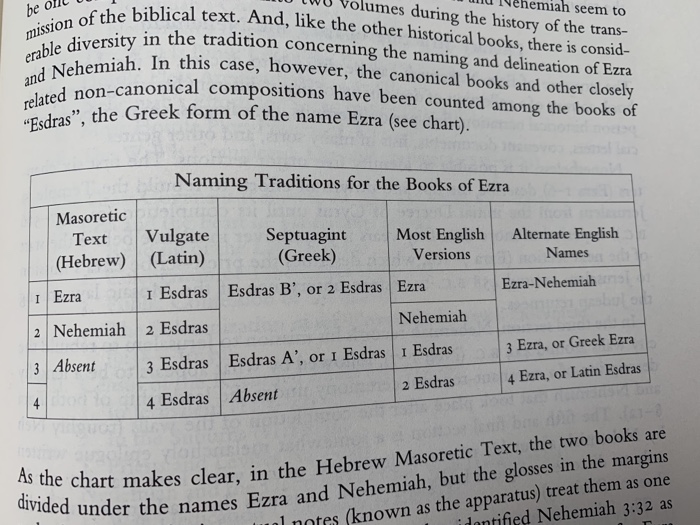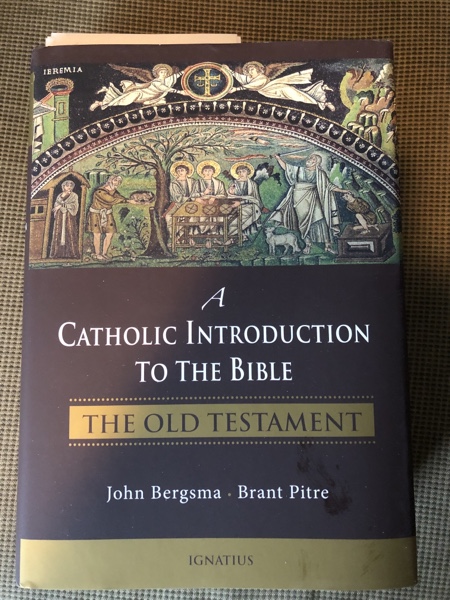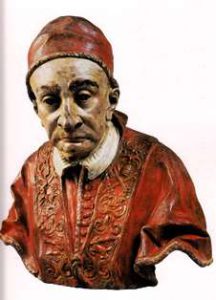Today is the feast of St. Ezra or Esdras.
In the 5th c. BC, the Persian Artaxerxes allowed a scribe named Ezra to return to Jerusalem to restore the Temple worship and the law of Moses. At Jerusalem he finds that the people have fallen into pagan practices. Some years later, Nehemiah will go to Jerusalem.
 Some of you may not know that Holy Church considers many Old Testament figures to be saints. You can find them commemorated in the pages of the Martyrologium Romanum. Today, we have…
Some of you may not know that Holy Church considers many Old Testament figures to be saints. You can find them commemorated in the pages of the Martyrologium Romanum. Today, we have…
2. Commemoratio santi Esdrae, sacerdotis et scribae, qui, tempore Artaxerxis regis Persarum, Babylone in Iudaeam rediens populum dispersum congregavit et omni studio enisus est, ut legem Domini investigaret, impleret et doceret in Israel.
You can give us your own perfect but still smooth and elegant version in English.
Here is a pic from A Catholic Introduction to the Bible: The Old Testament by John Bergsma and Brant Pitre published by Ignatius Press. It shows the variant divisions of books, across the different versions. As you can see, it’s complicated.

I warmly recommend this book, especially to my fellow priests.

Speaking of Artaxerxes…
I can’t help but mention one of the more enlightening but weirdest baroque operas I have ever seen, Artaserse by Leonardo Vinci after a libretto by Metastasio. It premiered in Rome in 1730 in a theater on the Via Margutta (which I wrote about during my last trip to Rome… the street, not the theater). In those days, women were forbidden on the stage, and so male sopranos and castrati, also en travesti, sang the roles.
Now for the weird.

There was a production of Artaserse in 2012 with an all male cast, of countertenors. It was an odd thing to watch, since the artistic approach seemed to blend in support aspects of Japanese Noh theater. This is reflected in makeup and the fact that you see the stagehands in black, as if they are “invisible” and you are taken out of the stage and into the wings, which becomes part of the stage as a result. US HERE – UK HERE
It is hard to imagine that a male, human voice can do some of these things.
 You have to imagine an over-the-top baroque theater in Rome in the early 18th century, full of people with wigs and snuff boxes, perhaps wearing cloaks and masks.
You have to imagine an over-the-top baroque theater in Rome in the early 18th century, full of people with wigs and snuff boxes, perhaps wearing cloaks and masks.
The opera premiered during carnovale on 4 Feb 1730. The old Benedict XIII, Orsini, once a Dominican friar, would die on 21 February. He had dedicated the Spanish Steps built by the French as a gift to the city (and their own glory). He was a terrible ruler as Pope – may have been, as we know – and allowed a corrupt cardinal to run amok, later excommunicated by Clement XII. Benedict’s cause has been opened and closed and opened several times, including in 2017! He is instantly recognizable.
Try to get your mind around the fact that, in 1730, these singers, especially the famous castrati, were fanatically acclaimed, more than great rock stars of our day. People went nuts for them. Composers, such as Handel, wrote operas around their voices, to showcase them.
Here’s Franco Fagioli… yes, you read that right… with “Vo solcando un mar crud”.
Artaxerxes… Ezra… Artaserse… Fagioli. That’s how we got here.


































” full of people with wigs and snuff boxes, perhaps wearing cloaks and masks. ”
Sounds like the pot luck after the TLM.
[No. It really doesn’t.]
Baroque opera was pretty barebones in presentation – ie, they went out and sang, and did their scene, and then the scene was over. Maybe you had dances between scenes.
So there’s this obsession with overproducing baroque opera, instead of showcasing the singing and the lyrics.
There’s also this weird tendency of modern countertenors to copy women’s singing, when female opera singers originally copied _their_ style, and had to learn to do bel canto in their own ways.
I like the guy who was a bass-baritone for years and years before discovering his countertenor notes, because he comes across with a high masculine singing voice rather than fake-female or imitation-falsetto.
This was a fun read. That is some weird baroque music, all right. I’ve shared this with a friend who’s a scholar of that period, and a professor of literature at the University if Victoria, in the hopes of learning more. I’ll share what she tells me, if anything, with you when I hear back.
One cannot say enough good things about Pitre’s & Bergsma’s book- hopefully a similar introduction to the NT will follow. The references and background material is a great aide to understanding the text.
Pingback: SVNDAY EDITION – Big Pulpit
Helpful book by Bergsma and Pitre.
Archaeology news from Israel:
Rare inscription relating to the Book of Judges found in southern Israel
For the first time: an inscription from the time of the biblical Judges and relating to the Book of Judges has been recovered from excavations at Khirbat er-Ra‘i, near Kiryat Gat. The rare inscription bears the name ‘Jerubbaal’ in alphabetic script and dates from around 1,100 BCE. It was written in ink on a pottery vessel and found inside a storage pit that was dug into the ground and lined with stones.
Prof. Garfinkel and Ganor explain, “The name Jerubbaal is familiar from biblical tradition in the Book of Judges as an alternative name for the judge Gideon ben Yoash. Gideon is first mentioned as combatting idolatry by breaking the altar to Baal and cutting down the Asherah pole. In biblical tradition, he is then remembered as triumphing over the Midianites, who used to cross over the Jordan to plunder agricultural crops.
The Jerubbaal inscription also contributes to our understanding of the spread of alphabetic script in the transition from the Canaanite period to the Israelite period.
https://mfa.gov.il/MFA/IsraelExperience/History/Pages/Rare-inscription-relating-to-the-Book-of-Judges-found-12-July-2021.aspx
Archaeology news from Egypt and Jeremiah 37:5.
While digging in his field, an Egyptian farmer recently made the discovery of a lifetime, a roughly 2-meter-tall royal stele. The stele, which was discovered near the Egyptian city of Ismailia, 62 miles northeast of Cairo, appears to commemorate a foreign campaign of Apries [or Hophrah] (r. 589–570 B.C.E.), an Egyptian pharaoh of the 26th Dynasty who is remembered in the Book of Jeremiah as having come to Jerusalem’s aid during the Babylonian siege (Jeremiah 37:5).
The sandstone stele, which includes the cartouche of Apries and 15 lines of hieroglyphic text, stands 2.3 meters tall and is just over a meter wide.
https://www.biblicalarchaeology.org/daily/ancient-cultures/ancient-egypt/new-stele-of-biblical-pharaoh-found/
Another recent discovery, this one in Rome.
Archaeologists have discovered a rare stone delineating the city limits of ancient Rome that dates from the age of Emperor Claudius in 49 A.D. and was found during excavations for a new sewage system.
In ancient Rome, the area of the pomerium was a consecrated piece of land along the city walls, where it was forbidden to farm, live or build and through which it was forbidden to enter with weapons.
At a press conference in the Ara Pacis museum near the mausoleum, Claudio Parisi Presicce, director of the Archaeological Museums of Rome, said the stone had both civic and symbolic meaning.
https://www.archaeology.org/news/9857-210719-rome-pomerium-stone
Recent archaeology news from Merrye Olde Englande, the Norfolk seal inscription was deciphered- it’s from Psalms in Latin.
The 13th or 14th Century seal, containing a reused Roman carved gem, was found in Gayton by a metal detectorist in August [2020].
Experts had suggested possible letters in the inscription, but Norfolk finds liaison officer, Dr Helen Geake, said it did not appear to show a generic motto and “hoped a Latin scholar might be able to decipher it”.
…
He [Alex Cortez of California, who referred to a Latin psalter] decided to attempt to decipher the message and responded to say it could be Psalm 36:27, “Declina a Malo, a fac bonum”.
Dr Geake said the suggestion was Psalm 37 in modern Bibles and meant “decline from evil and do good”.
https://www.bbc.com/news/uk-england-norfolk-57678500
There is some resemblance between the Pachamama (goddess of fertility, agriculture, mountains) rituals at the Vatican in 2019 and the cult of Osiris (fertility, agriculture (or vegetation), and the afterlife (Osiris is prominent in the Book of the Dead, and eventually is associated with just judgement and resurrection)) at Abydos but it’s not conclusive.
On this particular matter, there is some connectivity from Rudolf Steiner to the current Vatican via Leonardo Boff and Claudio Hummes of the 2019 Amazon Synod (but influences of Carl Jung and Joseph Campbell are also noted).
Briefly, the cult of Osiris had an annual festival at Abydos. Osiris priests carried an idol of Osiris in a boat and processed from the temple down into a wadi known as the “sacred land,” then ascended to a necropolis known as Umm alQa’ab (Arabic: “mother of pots”). Stele were erected along the way, and there are hieroglyph references to “kissing the ground” and “giving praise.”
More specifically, “sacred land” is written with Gardiner Sign List N16, D45 (arm holding a scepter, the “magic wand” (“nhbt”) interpretation of D45 is important to Wicca and Heka), N25.
The 2019 bowls with dirt and a red color are part of Pachamama rituals.
The hieroglyph for bowl is W24 (phonetic value “nw”).
The hieroglyph for “lord” is not a bowl but a wicker basket, V30 (phonetic value “nb”), which resembles a bowl.
V30 is related to the “Wepwawet” procession of “combat” prior to the great Osiris procession. The name “Wepwawet” means “opener of the ways.” Wepwawet is an ancient pagan wolf deity that almost certainly pre-dates the pharaohs. The title of Wepwawet is “lord (V30) of the sacred land.” In this usage (Wepwawet’s title), “sacred land” appears to refer not to the wadi but to the necropolis itself.
At some point during the Middle Kingdom W24 was written together with the unclassified Aa27- the intention for this combination is unknown. Aa27 is presumed to be some sort of tool related to grinding or milling.